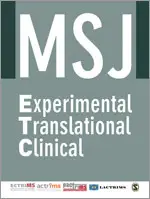Secondary progressive multiple sclerosis (SPMS) represents an important stage in the development of multiple sclerosis, but is often difficult to diagnose accurately. The study, conducted in five European countries, used objective classifiers to determine the proportion and characteristics of SPMS in different registries of multiple sclerosis patients, including the national ReMuS registry. The findings suggest that SPMS may be systematically underdiagnosed in these registries. This article provides a detailed comparison of the methods used to classify SPMS and their results in each of the participating registries.

Forsberg, L., Spelman, T., Klyve, P., Manouchehrinia, A., Ramanujam, R., Mouresan, E., Drahota, J., Horakova, D., Joensen, H., Pontieri, L., Magyari, M., Ellenberger, D., Stahmann, A., Rodgers, J., Witts, J., Middleton, R., Nicholas, R., Bezlyak, V., Adlard, N., Hach, T., Lines, C., Vukusic, S., Soilu-Hänninen, M., van der Walt, A., Butzkueven, H., Iaffldano, P., Trojano, M., Glaser, A., Hillert, J., SPMS Research Collaboration Network (2023). Proportion and characteristics of secondary progressive multiple sclerosis in five European registries using objective classifiers. In Multiple Sclerosis Journal - Experimental, Translational and Clinical (Vol. 9, Issue 1, p. 205521732311535). SAGE Publications. https://doi.org/10.1177/20552173231153557 PMID: 36816812
Abstract
Introduction: Establishing a diagnosis of secondary progressive multiple sclerosis (SPMS) can be difficult and the proportion of people with SPMS varies between analyses. An objective method for classifying disease progression may provide a better estimate of the relative proportion of relapsing-remitting multiple sclerosis (RRMS) and SPMS and may identify situations where SPMS is under-reported.
Materials and methods: Data were obtained from 61,900 MS patients from MS registries in the Czech Republic, Denmark, Germany, Sweden and the United Kingdom (UK), including date of birth, sex, year of conversion to SPMS, visits with Expanded Disability Status Scale (EDSS) scores, date of MS disease onset and date of MS diagnosis, relapses and use of disease-modifying treatment (DMT). We included patients with RRMS or SPMS with at least one visit between January 2017 and December 2019 if the patient was at least 18 years of age. We used three objective methods: a set of inclusion criteria for SPMS clinical trials ("EXPAND criteria") adapted for the clinical practice setting, a modified version of the MSBase algorithm, and a recently published decision tree-based algorithm.
Results:: Clinically determined SPMS rates ranged from 8.7 % (Czech Republic) to 34.3 % (UK). Objective classifiers estimated SPMS rates from 15.1 % (Germany according to EXPAND criteria) to 58.0 % (UK according to decision tree method). Due to different requirements for the number of EDSS ratings, classifiers varied in the proportion they were able to classify; from 18 % (UK according to the MSBase algorithm) to 100 % (decision tree algorithm for all registries). Objectively classified SPMS patients were older, converted to SPMS later, had higher EDSS at index date and higher EDSS at conversion. More objectively classified patients with SPMS were on DMT compared with clinically diagnosed patients.
Conclusion:A: SPMS appears to be systematically underdiagnosed in MS registries. Reclassified patients were more likely to be on DMT.
You can read the full article in English on the magazine's website Multiple Sclerosis Journal - Experimental, Translational and Clinical.

